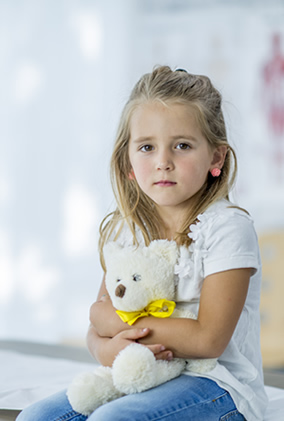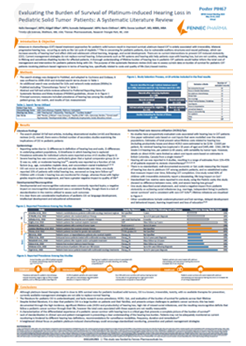
Cisplatin-Induced Hearing Loss
Childhood Cancer Hearing Loss Patient Focused Drug Development (PFDD) Meeting
The pediatric patient population with chemotherapy-induced hearing loss represents a segment of the cancer survivor community with a severe burden of disease with great unmet medical need. An externally led, FDA-approved Patient Focused Drug Development (PFDD) meeting on September 13, 2018, near Washington, DC, explored these issues in depth.
Overview of cisplatin-induced ototoxicity
When soundwaves travel through the inner ear, they stimulate sensory hair cells which trigger the nervous system to communicate with the auditory cortex of the brain. Platinum-based therapies like cisplatin can cause ototoxicity by damaging these hair cells which cannot regrow. This can result in irreversible hearing loss.1

Cisplatin is considered a cornerstone of treatment for pediatric cancer. However, ototoxicity is a common consequence of treatment.2 Young children are especially vulnerable to the ototoxic effects of cisplatin-based chemotherapy since their ears are still developing.1 Because this is a dose-limiting toxicity, the risk increases alongside the amount of cisplatin administered.2 The impact of ototoxicity may be permanent, severe, and profound—with the potential to significantly impair cognitive performance and the development of social and language skills.1
Current interventions such as hearing aids are implemented after hearing loss has occurred. They do not replace normal hearing and can be challenging for children to use.1 The overall survival rate for children with localized, nonmetastatic disease is close to 80%, making the permanent and progressive impact of ototoxicity an important consideration.3,4
Understanding how cisplatin-induced ototoxicity occurs
- Cisplatin-induced ototoxicity is characterized by the production of toxic levels of reactive oxygen species within the cochlea, resulting in the destruction of cochlear hair cells and damage to the stria vascularis and spiral ganglion cells1
- Once cochlear hair cells are destroyed, they cannot grow back1
- This damage is generally dose dependent, bilateral (affecting both sides), and irreversible1
- The resulting hearing loss can also be accompanied by tinnitus and vertigo1

Learn more about cisplatin-induced hearing loss
The majority of cisplatin-treated pediatric patients will develop ototoxicity
- Approximately 5000 children (≤18 years) are diagnosed with a solid tumor and treated with platinum-based chemotherapy such as cisplatin every year in the United States5,6
- Approximately 70% (3500) of these children are diagnosed with localized, nonmetastatic disease7
- At least 60% of pediatric cancer patients develop ototoxicity from platinum-based chemotherapy such as cisplatin2
Recognizing the signs and symptoms
Signs and symptoms seen in children as ototoxicity develops include:
- High-frequency (≥4 kHz) sensorineural hearing loss that is bilateral (affecting both sides), progressive, and irreversible1,2,8
- Progression of hearing loss to involve lower frequencies (<4 kHz)
- Tinnitus1,2
- Vertigo1,2
- Hearing loss that can continue to progress due to prolonged retention of platinum after completion of therapy2
Onset can occur early into treatment with cisplatin
- Just 1 cisplatin treatment cycle can lead to a lifetime of hearing loss2
- Hearing can deteriorate even after treatment is over2

The impact of ototoxicity can be lifelong and severe
- Progressive and irreversible hearing loss can have a profound impact on children1,2,9,10
- The burden of hearing loss exerts a toll on many crucial aspects of their life, such as9:
- Speech and language skills
- Social-emotional development
- Academic performance
- Even as they grow older, hearing loss is associated with10:
- Depression
- Underemployment
- Reduced earnings
- Social functioning problems
- Not graduating high school
- Not living independently
- Never marrying
Non-pharmacological interventions are not preventative
- Non-pharmacological interventions are implemented after hearing loss has occurred1
- Hearing aids
- Do not restore normal hearing1
- Unable to separate speech and noise in noisy environments1
- Daily use and care may be challenging for children1
- Those with ototoxic hearing loss are more likely to benefit from advances in technology like extended bandwidth hearing aids or hearing aids with frequency-lowering technology11
- Cochlear implants
- A surgically implanted neuro-prosthetic device to provide a modified sense of sound for moderate to profound sensorineural hearing loss1
- Require commitment to audiology and speech therapy rehabilitation programs1
References:
- Landier W. Ototoxicity and cancer therapy. Cancer. 2016;122(11):1647-1658.
- Langer T, am Zehnhoff-Dinnesen A, Radtke S, et al. Understanding platinum-induced ototoxicity. Trends Pharmacol Sci. 2013;34(8):458-469.
- Hennegan K, Silber A, Dehipawala S, Chithran K, Lockhart D. Evaluating the burden of survival of platinum-induced hearing loss in pediatric solid tumor patients: a systematic literature review. ISPOR Annual Meeting 2020. May 18-20, 2020 [Virtual]. Poster PIH67.
- Freyer DR, Brock PR, Chang KW, et al. Prevention of cisplatin-induced ototoxicity in children and adolescents with cancer: a clinical practice guideline. Lancet Child Adolesc Health. 2020;4(2):141-150.
- Ward E, DeSantis C, Robbins A, et al. Childhood and adolescent cancer statistics, 2014. CA Cancer J Clin. 2014;64:83-103.
- National Cancer Institute website. https://seer.cancer.gov/stdpopulations/stdpop.19ages.html. Accessed January 29, 2020.
- Perkins SM, Shinohara ET, DeWees T, Frangoul H. Outcome for children with metastatic solid tumors over the last four decades. PLoS One. 2014;9(7):e100396.
- Waissbluth S, Del Valle A, Chuang A, Becker A. Incidence and associated risk factors for platinum-induced ototoxicity in pediatric patients. Int J Pediatr Otorhinolaryngol. 2018;111:174-179.
- Clemens E, van den Heuvel-Eibrink MM, Mulder RL, et al. Recommendations for ototoxicity surveillance for childhood, adolescent, and young adult cancer survivors: a report from the International Late Effects of Childhood Cancer Guideline Harmonization Group in collaboration with the PanCare Consortium. Lancet Oncol. 2019;20(1):e29-e41.
- Bass JK, Knight KR, Yock TI, et al. Evaluation and management of hearing loss in survivors of childhood and adolescent cancers: a report from the Children’s Oncology Group. Pediatr Blood Cancer. 2016;63(7):1152-1162.
- Paken J, Govender CD, Pillay M, Sewram V. Cisplatin-associated ototoxicity: a review for the health professional. J Toxicol. 2016;2016:1809394.
